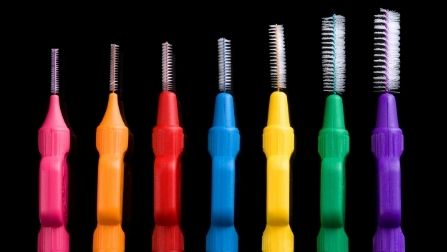Even though cleaning perforated leather car seats isn’t much different when compared to standard leather seats, there are a few key steps that you should follow to make perforated seats perfectly clean, which I’ll show you in this post.
Key Takeaways:
- Vacuum thoroughly to remove loose dirt and debris.
- Use a gentle leather cleaner and brush to clean the perforated surfaces.
- Wipe with a microfiber towel to remove any residue.
- Apply leather conditioner to protect the leather and prevent cracking.
How To Clean Perforated Leather Seats In 4 Easy Steps

Here are the 4 quick steps for cleaning leather car seats with holes.
1. Vacuum The Seats, Especially The Perforated Parts
Start by thoroughly vacuuming the leather seats, placing extra emphasis on the tiny holes characteristic of perforated leather.
These perforations are prone to trapping dirt, making them more challenging to clean than standard leather seats. Take your time during this step to ensure that you remove all the dirt from each individual hole.
In addition to being thorough, it’s crucial to be gentle during the vacuuming process to avoid damaging the leather. Unlike regular leather seats, perforated ones require a more meticulous approach. Use a gentle vacuum nozzle and proceed carefully to ensure you don’t scratch or damage the seats.
2. Use a High-Quality Leather Cleaner and Leather Brush
After vacuuming, the next step is to clean the leather using a high-quality leather cleaner and a specialized leather cleaning brush.
Spray the cleaner onto the brush rather than directly onto the seats, and start agitating the seats, paying specific attention to cleaning all the dirt from the holes.
Leather cleaner I recommend:
Make sure not to use too much cleaning solution. It’s better to use less solution and repeat the process twice than to use too much solution.
Just make sure to use a dedicated leather cleaning brush since they are sensitive but still strong enough to clean car leather seats. You don’t want to damage anything.
3. Wipe The Excess With a Clean Microfiber Towel
After brushing, wipe down the seats with a clean microfiber towel to remove any excess cleaner. If you notice product buildup in the perforations, a second round of vacuuming may be needed to fully clear them.
For particularly dirty seats, you can dampen the microfiber towel with a bit more cleaner to ensure thorough cleaning.
4. Apply Leather Conditioner
Lastly, you should condition perforated leather seats to make them last longer and prevent cracking. Buy yourself some high-quality leather conditioner, pour it into a clean microfiber towel, and apply it to the leather seats.
If you want more lasting and better protection, consider applying some ceramic coatings for leather.
Remember, conditioned leather lasts much longer, and it’s only a few minutes of extra work when you’re already cleaning the seats.
Additional Tips For Cleaning Tiny Holes Full Of Dirt
For stubborn dirt trapped in the perforations, additional cleaning methods are available.
Choose techniques based on your available detailing equipment. These extra steps are only necessary for areas that remain dirty even after initial cleaning.
By focusing only on the problem areas, you save time. I also advise you to combine multiple methods for effective cleaning, as relying on a single approach may not yield thorough results.
1. Air Compressor
An air compressor is a useful tool for both professional and hobbyist auto detailers, particularly for cleaning perforated leather seats, especially if they’re also ventilated, so you need to make sure there isn’t any moist inside.
If dirt remains trapped in the tiny holes, connect an air blower gun to your compressor and use compressed air to dislodge it. This method is effective for removing solid particles like rocks, food, or dust.
After using the air compressor, a quick wipe-down or vacuuming may be necessary to clean up any dislodged dirt.
2. Toothpick, Interdental Brush, or Gum Stimulator

For targeted cleaning of stubborn dirt in perforated seats, tools like toothpicks, interdental brushes, or gum stimulators can be effective. These are especially useful for cleaning individual holes that remain dirty after general cleaning.
Interdental brushes are particularly effective but contain metal parts that could damage the leather, so caution is advised. Gum stimulators are a safer but equally effective alternative.
After using any of these tools, it’s important to wipe them with a microfiber towel to prevent re-depositing dirt back into the holes.
3. Steam Cleaner
A steam cleaner is a valuable tool for auto detailing, especially for tackling old spills like milk or chocolate trapped in perforated leather seats. The steam softens and breaks down the stains, making them easier to remove with a brush, vacuum, or microfiber towel.
However, a steam cleaner is most effective when used in combination with other tools. Using it alone won’t fully remove dirt from the tiny perforations.
4. Use a Very Thin Vacuum Nozzle When Vacuuming
Using a thin nozzle on your vacuum increases suction power, which is crucial for cleaning perforated leather seats. The narrow nozzle focuses the vacuum’s power on small areas, making it more effective at removing trapped dirt.
I recommend you use this nozzle:
While a high-powered vacuum isn’t necessary, the thin nozzle is key. It’s most effective when used as a follow-up to other cleaning methods like air compressors or steam cleaners to ensure thorough cleaning.
Common Mistakes To Avoid When Cleaning Perforated Leather Car Seats
Here are some of the most common mistakes you should avoid when cleaning perforated leather car seats:
- Overusing Cleaner: Applying too much leather cleaner can lead to product buildup in the perforations, making it difficult to remove later.
- Direct Spraying: Spraying cleaner directly onto the seats can cause the liquid to get trapped in the tiny holes, leading to potential mold or mildew issues.
- Using the Wrong Tools: Utilizing brushes that are too harsh can scratch or damage the leather. Always opt for tools specifically designed for leather cleaning.
- Skipping Vacuuming: Failing to vacuum thoroughly before cleaning can result in pushing dirt further into the perforations.
- Ignoring Follow-Up Steps: Neglecting to wipe down or re-vacuum after cleaning can leave residue or trapped dirt, diminishing the overall effectiveness of the cleaning process.
- Single-Method Cleaning: Relying solely on one cleaning method, like only using a steam cleaner, won’t fully remove dirt from the perforations. It’s best to combine multiple methods for a thorough cleaning.
- Rushing the Process: Cleaning perforated leather seats requires time and attention to detail. Rushing through the steps can lead to subpar results and potential damage.
- Not Testing Products: Failing to test cleaning products on a small, inconspicuous area before full application can result in discoloration or damage to the leather.
By avoiding these common mistakes, you’ll be more likely to achieve a thorough and safe cleaning of your perforated leather car seats.
Frequently Asked Questions
Standard leather seats are fully covered, thus making them less breathable. On the other hand, perforated leather seats have tiny holes in them. Those holes make the seat more breathable, which makes it more comfortable for passengers.
Unfortunately, perforated leather seats may be a bit trickier to clean than standard car leather seats. Removing the dirt from those tiny holes is usually the trickiest part.
Yes, conditioning is recommended to maintain the leather’s quality and prolong its life.
Wipe the seats with a damp microfiber towel, then clean it with a leather cleaner and detailing brush, and then vacuum the seats by using a narrow vacuum nozzle. If needed, use a toothbrush to remove any leftovers.
To maintain perforated leather, you should regularly clean it, pay specific attention to holes, and then apply high-quality leather conditioner.


